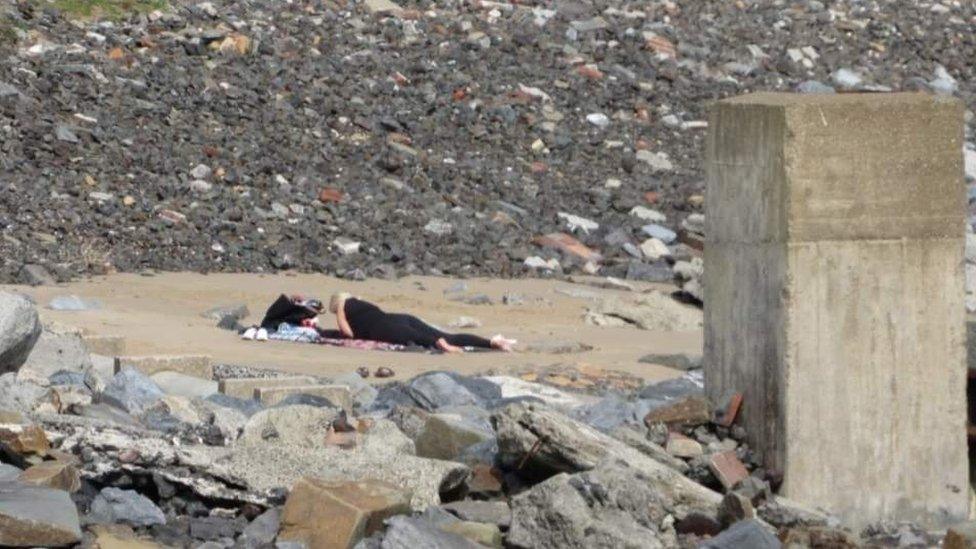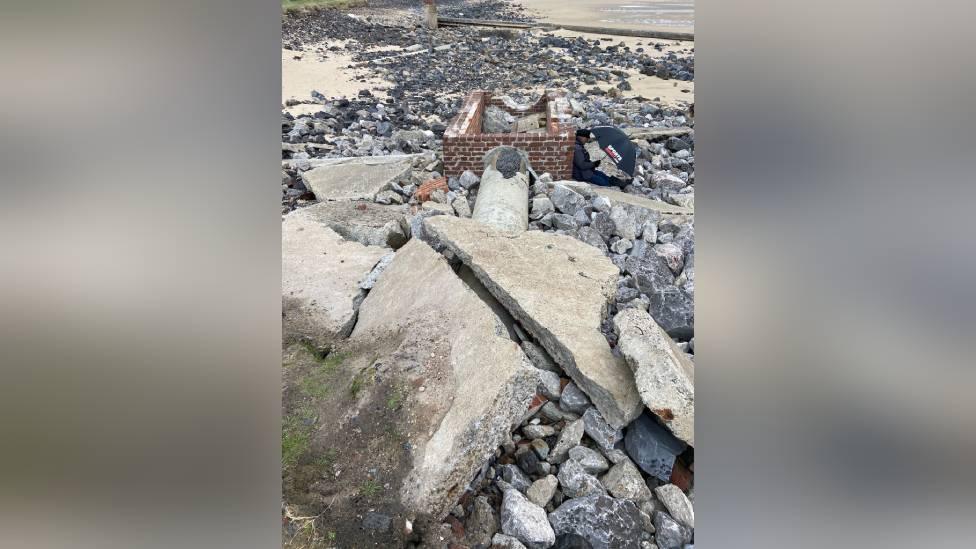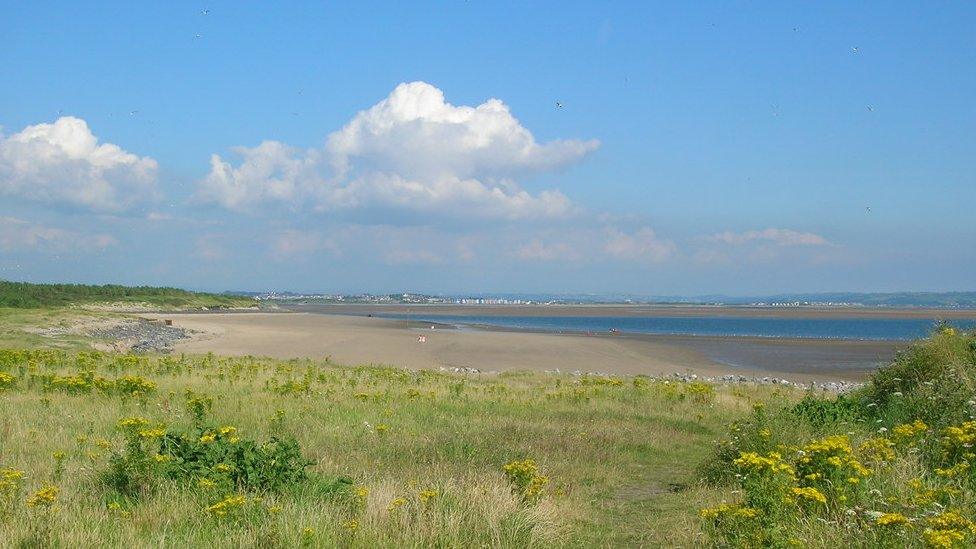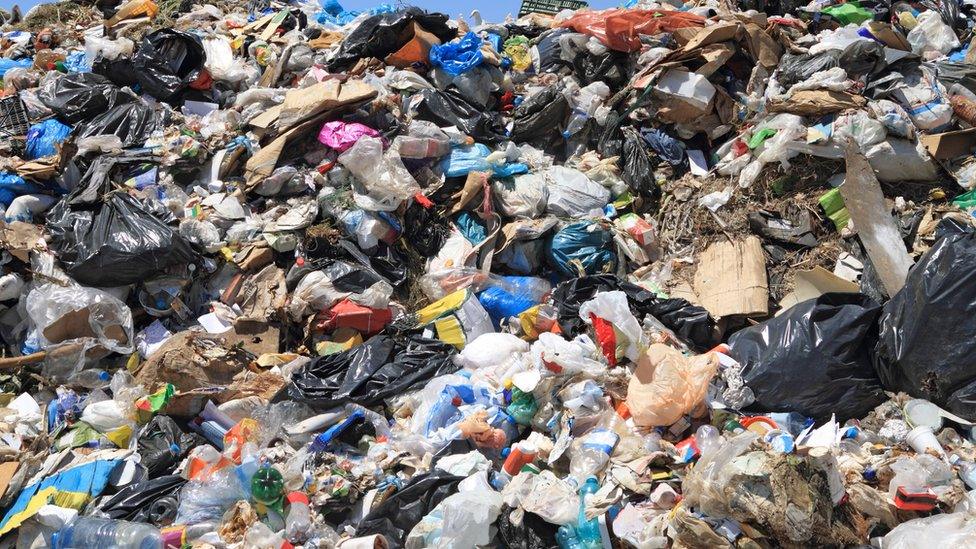Burry Port: Fear for children after asbestos found on beach
- Published

Residents say they fear for the health of people they have seen sunbathing and having BBQs where they found asbestos
Campaigners are fighting for asbestos waste to be removed from a beach in Carmarthenshire.
The east beach at Burry Port lies close to the site of a former power plant, which was demolished 20 years ago.
A campaign group has paid for tests which found asbestos on the beach, where children play and build sandcastles, and said coastal erosion could increase the risks to the public.
Carmarthenshire council said its own tests found "low risk" asbestos.
The authority arranged tests to be carried out after concerns were raised about the material found on the beach, according to the Local Democracy Reporting Service.
The campaign group disagreed with the council's findings, adding that the results of their privately-funded tests were "alarming and shocking".
Campaigner Tristam Evans said: "I got in contact with an asbestos laboratory [in] Bristol, they sent out five tests, I paid for them.
"We did five tests 400 yards apart down the coastline at Burry Port east… one came back white and blue asbestos, and it was in an area close to the harbour and kids' skate park.
"Being where it was I ordered a test kit again… the four we did in the erosion bank came back white or blue [asbestos]… plus the asbestos sheets eroded are soft and flaky due to the sea smashing them on the rocks."
What is asbestos?

Lumps of rock were found to contain asbestos
Asbestos minerals were once widely used in construction due to their heat resistance and strength, but have since been banned.
Public Health Wales said damaged asbestos can release fibres which, if breathed in for long periods of time and in high concentrations, can result in heart problems, breathing difficulties and lead to lung cancer.
Low levels of exposure over a long period of time, it added, can also damage health. There are strict rules about how asbestos and materials containing it must be disposed.
It is believed that the grey, corrugated pieces of debris found on the beach are remnants from the vast Carmarthen Bay Power Station, which occupied land behind the beach before it was demolished in the 1990s.
Jacqueline Mills, a member of the campaign group which paid for asbestos tests, said there had been high hopes for the area once the power station had gone, but coastal erosion had unearthed a worrying legacy.
"We thought everything was going to be great and it turns out when they blew up and dismantled the power station, rather than removing the rubble and the waste and the massive amount of asbestos that lined all of the chimneys, they decided to bury it," she said.
"The state of the harbour at the moment - the whole place to me is a death trap. I won't let my grandchildren go anywhere near it."
She accused the council of being "in denial" and called on them to "make the area safe".
"The more I looked into it myself, the more horrified I became," she said.
"We're just concerned that somebody's going to get seriously hurt or worse."
She said erosion had exposed bits of asbestos, originally thought to be rocks, that have been spread further.
"People have since reported seeing it in other locations around the area," she said.
"Obviously the concern with that is if it's spreading from the east beach where it was contained to the west beach and it's obviously going to get into the sea, the next place it's going is Pembrokeshire and the Gower.
"But despite all of that, Carmarthenshire [council] are still determined to play down the problem.
"With everything that's going on in the world, environmental issues bother me more than ever - this is a disaster waiting to happen."
What has been found on the beach?

Enviable views - but campaigners are asking what lurks between the rocks
The south-facing beach has enviable views across the Loughor Estuary to Gower, but is strewn with brick rubble, rusting metal rods and broken concrete pipes from the power plant.
The council has put up signs in the area warning people material which may contain asbestos had been found.
It also has big plans to regenerate the Burry Port Harbour area, including a scheme in partnership with a private developer for up to 360 homes on land between the former power station and the harbour.
Philip Hughes, executive board member for public protection at Carmarthenshire council, said: "Following inspections and testing, a small amount of material has been identified as containing low level asbestos.
"Whilst this is of low risk to the public we are taking all necessary steps as a precaution including the safe removal of any visible material. Signage has also been erected in the area."
He added the council had taken specialist advice on the issue and was working closely with Public Health Wales, Natural Resources Wales and Burry Port town council.

EXPLORE WALES FROM HOME: Join Iolo Williams for a guided tour of Pembrokeshire’s hidden gems
ARTS AND HERITAGE: Lose yourself in Welsh creativity and culture

- Published24 May 2021

- Published3 April 2021

- Published26 February 2021
